Heating and Cooling Your Home
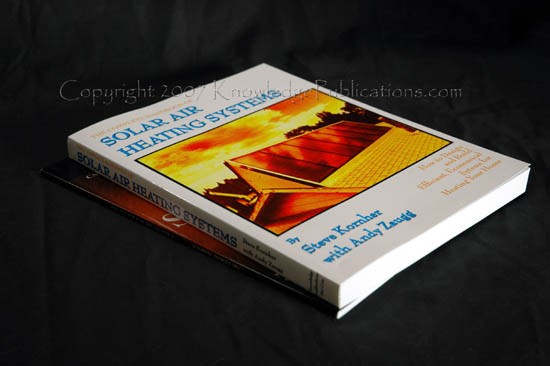
Solar Air Heating Systems $34.95
The Complete Handbook of Solar Air Heating Systems is incredibly detailed on HOW TO MAKE ANY solar air heater. Complete is the only way to describe this book. It covers all of the rules of thumb, the materials, where to get them and much, much more.
Whether you’re a homeowner or a contractor, this book has everything that you need to know about the construction and operation of all types of solar air heaters for space and domestic water heating. With their proven reliability and economy for both retrofit and new construction applications, solar air heaters have become one of the most popular home heating alternatives.
With over 125 detailed illustrations and 50 photographs contained within 350 massive pages, The Complete Handbook of Solar Air Heating Systems can lead YOU through a variety of solar projects. If you’re looking for one book that will get you into “hot air,” THIS IS THE ONE!

The Complete Handbook of Solar Air Heating Systems
How to Design and Build Efficient, Economical Systems for Heating Your Home
All of us are experiencing the problem that this book can help to ease: the rising cost of energy. The fuel bills for heating our homes and businesses are steadily rising every winter with no end in sight; and more and more of our income is required to maintain the level of comfort to which we have become accustomed. Weatherizing your house by caulking, weather stripping and adding insulation is a sure way to reduce your energy use and make your house more comfortable. Another approach is to replace an inefficient furnace or water heater with a more efficient one. You can also change to a cheaper fuel. Presently, gas and wood are typically cheaper fuels than oil and electricity. Sacrifice is yet another way to lower heating costs and is the approach many low- or fixed-income families must choose. Wearing sweaters and coats indoors and washing in cold water are reality for many people who are faced with a heat-or-eat situation.
However, no matter how much you conserve or sacrifice, if you live where it is cold in the winter, some heat simply must be added to your house in order for it to be reasonably comfortable. There is another option… we can look to the sun to produce this heat at a reasonable cost.
The purpose of this book is to help you avoid the high cost and unnecessary complexity of commercially manufactured solar air heaters by showing you how to build your own attractive, durable, low-cost collectors that deliver just as much heat as commercial systems costing over three times as much. SOLAR AIR HEATERS ARE EASY TO BUILD, and hundreds of owner-built collectors have been used successfully nationwide, but some deliver a lot more heat than others. Most of the do-it-yourself installations built at home would work a lot better if only one or two things were done differently. By presenting the basic principles involved and some of the mistakes made by others, this handbook will help you build a trouble-free, efficient and cost-effective solar heater.
Table Of Contents
Chapter 1: Keeping Warm: The Principles of Solar Heating
Adding Heat to Your House
Solar Systems: Passive and Active
Collectors
Site-Built Air Collectors
Chapter 2: A Survey of Air-Heater Options
Convective Air Heaters

Figure 2-1: To the left and below. Window box collectors and TAPs are easy-to-build collectors that deliver their heat by natural convection. They are best used to heat rooms that are frequently occupied and that require daytime heating. Window box collectors are self-damping at night. TAPs require lightweight backdraft dampers to prevent reverse thermosiphoning when the sun isn't shining.
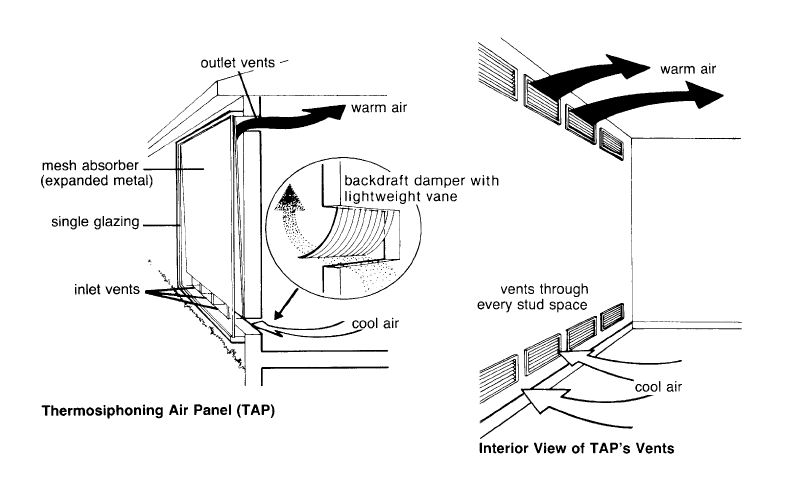
Active Systems

Figure 2-3: This two-mode system is simpler than it first appears. When the upper floor calls for heat and the collector is on, solar air is blown into the existing ductwork to warm the living area. When the needs of the upper floor have been satisfied, the motorized damper changes positions, and solar heat is delivered into the basement and stored in the concrete walls there. Note that two returns (inlets) to the collector, each with a backdraft damper, are required in this system.
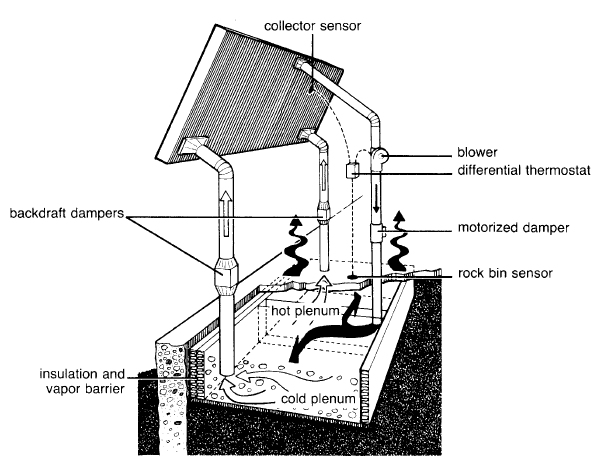
Figure 2-6: A good technique for storing solar heat in new construction involves blowing solar-heated air through an insulated gravel bed under a concrete slab floor. With this arrangement the collector operates very efficiently and the floor provides comfortable, radiant heat. Dampers prevent heat loss from storage at night.
Chapter 3: The Economics of Solar Heating
Payback
How Much Do Solar Heating Systems Cost?
What Are Your Heating Needs?
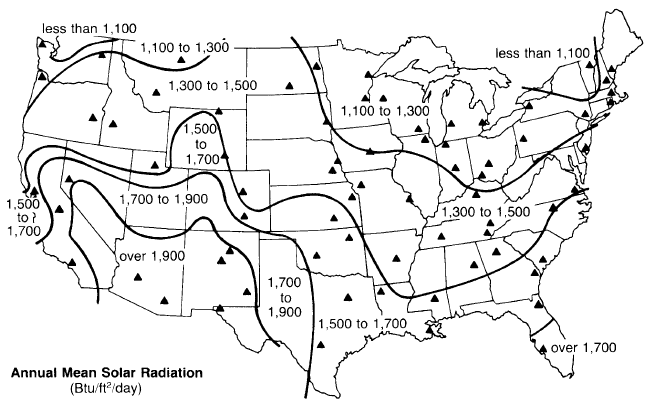
Annual Mean Solar Radiation (Btu/ft2/day)
Figure 3-2: This map shows the annual mean solar radiation available in the United States in Btu's per square foot per day. If your site doesn't receive much sunshine, you will need to build a larger collector in order to meet your needs.
Evaluating Your Site and Your Needs
Chapter 4: Chapter 4 Designing the Collector
The Sun at Your Site
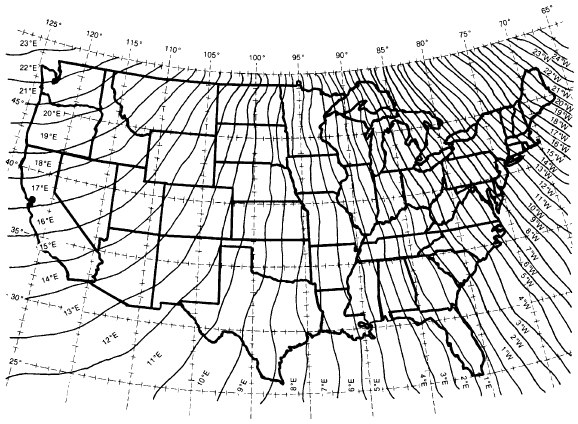
Figure 4-1: The first step in analyzing your solar site is to find true south. Looking at the position of the sun at noon (1:00 P.M. for daylight saving time) will give you a general idea, but for purposes of collector building we want a more accurate orientation and need to use a compass and a magnetic-variation map to find true north. It then becomes very easy to find true south. This isogonic map shows the approximate compass deviation from true south in the continental United States. For sites outside of this area, call the local airport for the deviation. For example, if you live in Denver, Colorado, your deviation is 131 degrees east. That is, true south is 132 degrees east of what your compass tells you is south. When using a compass, be sure to hold it away from all metal objects or the reading will be inaccurate.
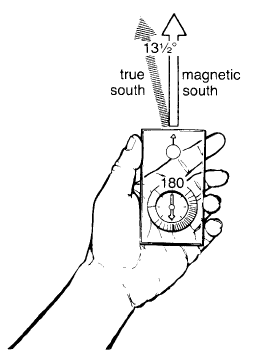
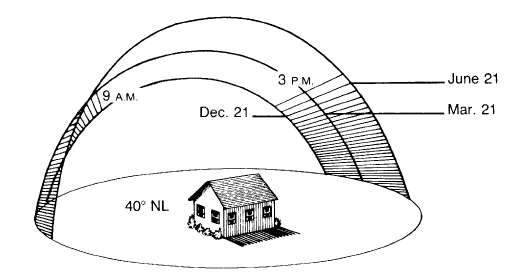
Figure 4-2: One way to visualize your solar exposure is to imagine a huge window in the sky south of your collector site. The top and bottom of the "solar window" at your site correspond to the summer and winter altitude angles. The sides of the window correspond to the sun's position at 9:00 A.M. and 3:00 P.M.
Design Considerations: Convective Air Heaters
Design Considerations: Active Collectors
Chapter 5: Construction Materials and Useful Tools—Choosing the Right Stuff
Collector Materials
Useful Tools
Chapter 6: Thermostats, Blowers and Dampers for Simple Active Systems
Thermostats
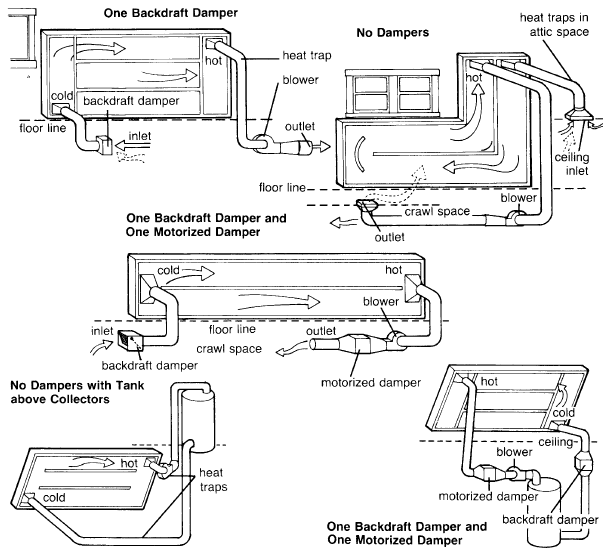
Figure 6-1: Preventing nighttime convective heat transfer from a cold collector is an important design consideration. This illustration shows damper placement to prevent this in three space heating and two water heating systems. Fewer dampers are required in systems where a heat trap is created in the ductwork.
Blowers
Dampers
Summer Venting
Wiring Simple Systems
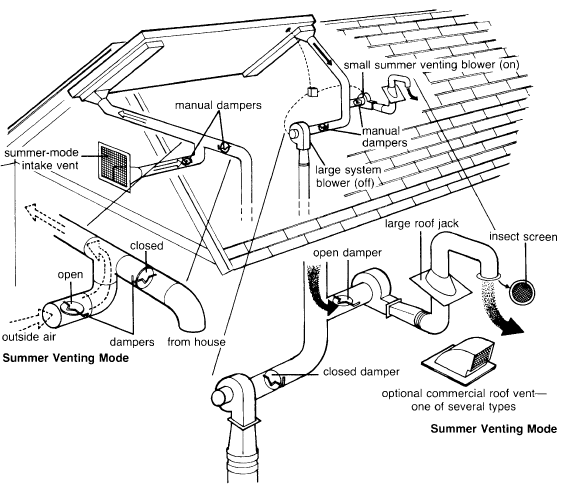
Figure 6-3: Summer venting of a tilted collector is done with a second, smaller blower (3/4 to 1 cfm per square foot) that power-ventilates the collector when temperatures reach 180°F. The manual dampers on the ducts that run to the outside must be very tightly sealed or plugged in the winter to eliminate air leaks that would lower the output temperature.

Figure 6-4: When wiring a differential thermostat, two wires must be run from the second junction box to the thermostat. The first junction box can be eliminated if the hot wire you tie into has enough slack in it. Wiring a remote bulb thermostat is easier because only a single line must be run to it—corresponding to the DT switch line above. It is a good idea to include a manual override switch in the line to the remote bulb. Use cable clamp fasteners throughout.
Chapter 7: Building Passive Air Heaters: The Window Box and the Thermosiphoning Air Panel
Building a Window Box Collector
Building a TAP
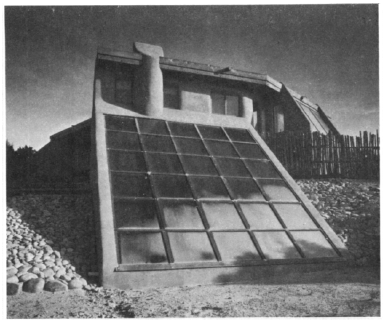
Photo 7-5: Large, tilted thermosiphoning systems that incorporate rock storage are becoming very popular in new construction in the southwest. The thermosiphon engineering for this system was by W. Scott Morris. Architecture and construction was by Mark Jones, AIA, of The Mark Jones Corporation. It can be difficult to retrofit a system like this because the collector has to be located below the house.
Chapter 8: Building Active Air Collectors Building a Roof-Mounted Collector
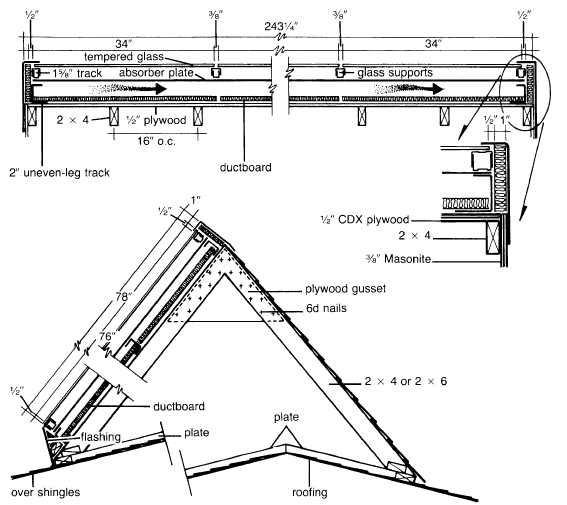
Figure 8-1: It's always a good idea to make detailed dimensional drawings for your collector to avoid surprises. Be sure to allow for 3/8-inch gaps between glass panes and for insulation on the sides of the collector. Our standard collector is 120 square feet in size and built around seven panes of 34-by-76inch tempered glass. The outside dimensions are 78 inches by 2431/4 inches. Note that any gaps between components are for visual clarity. All parts should be tight except where expansion is a factor.
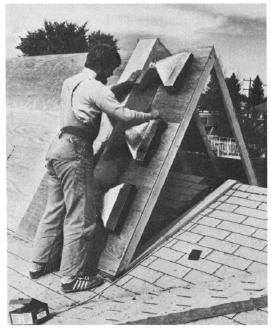
Photo 8-4: After the plywood collector backing is in place, you can position the manifold and accurately mark the holes for the inlet and outlet ports. Note that the north roof of the collector mount hasn't been completely sheathed, to allow for easier access when installing the manifolds behind the collector.
Mounting Collectors
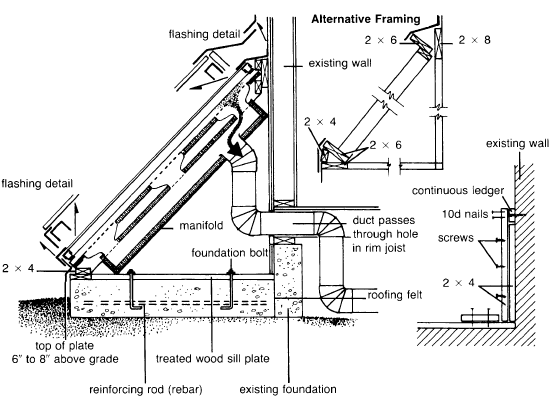
Figure 8-9: Shown here are several options for framing tilted, ground-mounted collectors. The collector framework must be securely attached to the existing wall with lag bolts. When the sides of the collector mount don't break over wall studs, attach them as shown in the detail at right.
All-Metal Collectors: Some Options
Building a Wood-Frame Collector
Retrofitting a Black-Roof Collector
Chapter 9: Designing and Installing Duct Systems
Ductwork Design .. 203
Duct Materials .. 204
Installing the Distribution System .. 210

Figure 9-3: Blowers mounted in a crawl space can simply sit on top of cinder blocks. In an attic they can be hung from rafters 'with padded plumber's strap to reduce vibration and to allow for quiet operation. Vibration collars are also essential for minimizing vibration noises. Gradual transitions to and from the blower, as shown in the attic installation, will help minimize resistance to airflow as the air enters and leaves the blower.
Building Manifolds
Do-It-Yourself Dampers
Static Pressure: Duct Design and Blower Selection
Chapter 11: Thermal Storage for Large Systems
Some System Design Options
Designing a Rock Box
Placement of the Rock Box
Storage Options
Storage and Hot Water Preheat
Passive Solar Plus Active Storage
A Super Crawl-Space-Storage System
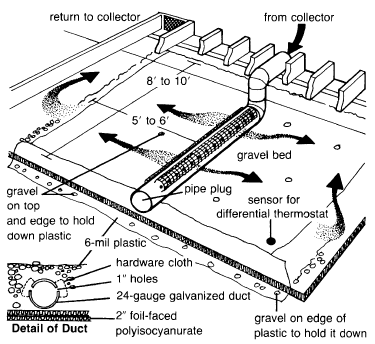
Figure 11-4: If you have a good-sized crawl space, you can store the heat from a large collector in a gravel bed located there. This simple system eliminates the need for the many controls that most systems with storage require.
Building a Thermal Storage Rock Box
Designing and Building a Slab-on-Gravel Storage
Chapter 12: Thermal Storage for Large Systems
The Gonzales Retrofit: Two Two-Modes
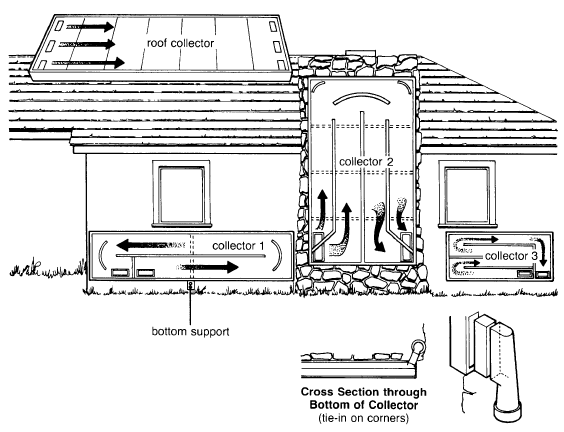
Figure 12-1: Each of the four collectors in the Gonzales system was built to accommodate 34-by-76inch panes of tempered glass, and each used a different baffling pattern to achieve a 20-foot (or more) flow of air behind the absorber. The ductwork for the three lower collectors runs directly into the crawl space through the rim joist. The ductwork for the roof mount runs through the attic before dropping through the house to the crawl space. The detail shows the tie-in to the large central collector.

Figure 12-2: This illustration shows the ductwork layout for the Gonzales system. Details 1, 2, and 3 relate to the space-heating two-mode system, detail 4 to the hot water system. Hot ducts are shaded, returns are white. Detail 1 shows the air delivery to either the crawl space or the back bedrooms. Detail 2 is of the ductwork "octopus" and transition to the blower. Returns to the vertical collectors are shown in detail 3. Detail 4 shows the damper arrangement in the crawl space for the roof-mounted, two-mode water-heating system.
The Nissley/Kratz Retrofit
The Etherton Retrofit
Dick Ward's System: Retrofitting a Warehouse
Silas Kopf's TAP
Ron Loser's Black-Roof Collector
Appendix 1 Sun Path Charts
Appendix 2 Wiring Schematics
Electrical Components and Terminology
Schematic: A Two-Mode System for Domestic Water and Crawl‑Space Heating
Schematic: A Two-Mode System for Space Heating
Schematic: Three- and Four-Mode Systems with Two Blowers
Checking the Control Wiring
Appendix 3 Working with Officials
Building Codes
Solar Easements
Financing
Tax Credits
Appendix 4 The Characteristics of an Efficient Flat Plate Collector
Appendix 5 Monitoring Your System
Appendix 6 Calculating Static Pressure
Index

Solar Air Heating Systems $34.95
The Complete Handbook of Solar Air Heating Systems is incredibly detailed on HOW TO MAKE ANY solar air heater. Complete is the only way to describe this book. It covers all of the rules of thumb, the materials, where to get them and much, much more.
Whether you’re a homeowner or a contractor, this book has everything that you need to know about the construction and operation of all types of solar air heaters for space and domestic water heating. With their proven reliability and economy for both retrofit and new construction applications, solar air heaters have become one of the most popular home heating alternatives.
With over 125 detailed illustrations and 50 photographs contained within 350 massive pages, The Complete Handbook of Solar Air Heating Systems can lead YOU through a variety of solar projects. If you’re looking for one book that will get you into “hot air,” THIS IS THE ONE!


